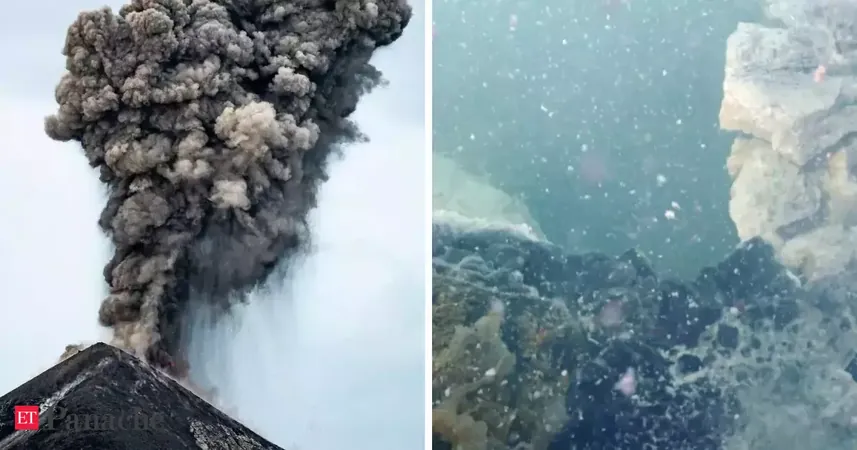
Warning Signs: Axial Seamount Volcano Off Oregon Coast Could Erupt as Soon as 2025!
2025-01-04
Author: Li
Warning Signs: Axial Seamount Volcano Off Oregon Coast Could Erupt as Soon as 2025!
Scientists are sounding the alarm as they predict that the Axial Seamount, an undersea volcano located near the Oregon coast, may erupt in 2025. Known as the most active submarine volcano in the Pacific, Axial has previously erupted in 1998, 2011, and 2015, demonstrating a pattern of frequent activity.
What makes this situation particularly concerning is the combination of advanced monitoring technology and observable geological changes in recent months. Researchers have reported distinct signs of impending volcanic activity, including ground inflation and clusters of small earthquakes. Ground inflation—an increase in the volcano's surface height—is often a telltale sign that magma is moving closer to the surface, heightening the risk of an eruption.
William Chadwick, a geologist at Oregon State University, noted during the American Geophysical Union's December 2024 meeting that the surface of Axial Seamount has risen to an alarming 95 percent of its pre-eruption level from 2015. Such forecasts represent a significant leap forward in volcanic prediction science, offering warning time that could potentially save lives and property in coastal communities.
Axial Seamount rises approximately 1,100 meters above the ocean floor and stretches 2 kilometers wide, lying 1,400 meters beneath the surface. The volcano has been continuously monitored through a sophisticated seafloor cable system that tracks seismic tremors and ground movements in real-time. This extensive setup has made it a focal point for researchers and scientists seeking to refine predictive models associated with volcanic behavior.
Indeed, the volcano's activity began to intensify from a period of dormancy between 2015 and 2023, showing renewed signs of life as early as late 2023. By mid-2024, scientists noted the ground was elevating at a rate approaching 25 centimeters annually—a rate that corresponds with the movement of magma promoting inflation.
However, following heightened activity, the volcano's inflation and seismic activity stabilized during the latter half of 2024, indicating that while an eruption is possible, there is no immediate cause for alarm. Experts stressed the importance of ongoing monitoring to ensure that any significant changes in behavior can be acted upon swiftly.
Researchers at the Scripps Institution of Oceanography consider Axial Seamount one of the most closely scrutinized underwater volcanoes globally. The data gathered from these observations not only aid in predicting future eruptions but also serves the scientific community's quest for a deeper understanding of volcanic mechanics.
In a groundbreaking approach, scientists are now incorporating artificial intelligence (AI) to delve deeper into the extensive data collected from Axial Seamount. This powerful tool aims to unlock insights into patterns and behaviors that could transform the ways scientists predict volcanic eruptions in the future, although they anticipate that volcanic activity may still present unpredictable challenges.
As the Axial Seamount prepares to potentially erupt again, this represents a pivotal moment in volcanic studies and monitoring efforts. With further advancements in technology and predictive modeling, researchers hope that they can continue to improve crisis management strategies for future volcanic events, not only for Axial but for other volcanoes around the world. Stay tuned, as developments unfold—the next significant chapter in the world of geology may be just around the corner!



 Brasil (PT)
Brasil (PT)
 Canada (EN)
Canada (EN)
 Chile (ES)
Chile (ES)
 Česko (CS)
Česko (CS)
 대한민국 (KO)
대한민국 (KO)
 España (ES)
España (ES)
 France (FR)
France (FR)
 Hong Kong (EN)
Hong Kong (EN)
 Italia (IT)
Italia (IT)
 日本 (JA)
日本 (JA)
 Magyarország (HU)
Magyarország (HU)
 Norge (NO)
Norge (NO)
 Polska (PL)
Polska (PL)
 Schweiz (DE)
Schweiz (DE)
 Singapore (EN)
Singapore (EN)
 Sverige (SV)
Sverige (SV)
 Suomi (FI)
Suomi (FI)
 Türkiye (TR)
Türkiye (TR)
 الإمارات العربية المتحدة (AR)
الإمارات العربية المتحدة (AR)